As India is preparing for the rollout end of this year to mid next year of 3G and WiMax services it represents a significant move forward for the Indian mobile telecoms Industry. I could find some very positive news that India to have 230 m 3G subscribers by 2013
3G and variations of it first got rolled out in Japan back in 2001. 3G essentially allows you to shift data faster over the mobile phone network thereby opening up many new services and possibilities (such as video telephony and high speed data services for downloading information and surfing the web). WiMax is similar to home wireless technology. Where-as home wifi only reaches out a few hundred feet, WiMax has a much wider range many across kilimeter. It also offers speeds that are far greather than 3G. To WiMax in to reality, just image that you can be anywhere in the city of Mumbai, lets say, and flip open your laptop and get on to the web instantly regardless of where you stand. Work from the park, the local Cafe Coffe Day, from home or at the airport terminal. WiMax allows this and that too at high speed.
The advantage of 3G to mobile phone operators is that there are a lot of phone models in the market aleady which already support 3G out-of-the-box. With further investment in installing 3G transmission towers the basic infrastructure for 3G in India can be rapidly rolled out. WiMax, on the other hand, could take a little longer to become widespread. The equipment necessary to receive WiMax signals isn’t readily available in India yet and transmissions in the WiMax spectrum is some-what limited to date. In India, Tata Communications has been experiementing with a WiMax trial and Bangalore and hopes to expand this across Mumbai and Delhi once spectrum has been allocated.
What really interests me is that WiMax has the potential to reach remote rural populations in India where existing mobile coverage is patchy or non-existant. This would open up the possibility of bridging the digital divide and binging the advantages of access to the Internet to whole new communities. History has shown that Internet access in rural areas of India has been mostly a good thing with a great examples being the e-Choupal project, which enables farmers to get price of grain and seed direct from market instead of going through the middle man via internet terminal in their villages and farms.
Access to the internet in rural areas also spreads the influence of better and wider education to all of India’s population, helping to unlock the latant tallent of a youthful and eager work force. Ultimately, however, as technologies like WiMax and 3G reach the masses, it will enable India to innovate and invent in ways it hasn’t done so before. Entepreneurs up and down the country as well as would-be entrepreneurs will suddenly have a new medium to release their ideas through. When I look at the divide between the uptake of broadband internet and mobile telephony in India, the choice today is clear. More Indian’s today own and use a mobile phone and the number of mobile subscribers dwarfs the number of broadband intenet subscribers. Everyone from your ricksha-wala to duba-wala, city slicker to gardener, cleaner to call centre worker now owns a mobile phone and the uptake is unstopable.
Although market saturation of mobile phone ownership is some years off in India, like its global counterparts, Indian telco’s will eventually start to feel the pinch and one way to sustain and increase revenue is to expand sevice offerings.
3G and WiMax will enable Indian telco’s to offer their subscriber base a multitude of new services including premium video content, video to video chat between hand-sets (and cross network), selling software to mobile phone business users and innovating in the burgeoning mobile phone games industry. Like it’s console games counterpart, mobile gaming is booming in International makets and there’s no reason why this shouldn’t be the case in India once the networks enable people to download large files to their phones. Culturally, Indian’s differ in many ways to the world at large and one of those differences is the high value placed on education. Nintendo already realises this and its DS games console, coupled with the plethora of recent educational titles that you play on the Nintendo DS is taking off like hot-cakes. This is a natural appeal and fit with the Indian psychi and mind-set.
Finally, 3G will allow Indian users to upload photos and videos from their phones to the web and partipicate in the mobile social networking space beyond the confines of SMS and becomes what is coined as citizen journalists. Indian teleco’s will probably offer a selection of data packages to subscibers, although like the west, most teleco’s will no-doubt standardise data tarrifs on flat rate “eat as much as you like” structures to reduce confusion and streamline billing.
There are countless ways the Indian telco’s and consumers will benefit from 3G and WiMax and I cannot wait for this market to blossom in India. With over 71 countries now offering 3G to its consumers, it’s time for India to join the 3G club and perhaps suplant it altogether with WiMax.
Go India go !



 While U.S. companies struggle to figure out how to monetize social media, India’s tech industry has quietly figured out a way to make hundreds of millions (maybe billions) by servicing it. Everything from simple comments on blog posts, to breaking sophisticated Google CAPTCHAs, Craigslist listings, Gmail invites, Yahoo personals, MySpace profiles, YouTube uploads, Facebook friends, and now I hear Twitter tweets are all being performed in India on behalf of social networking sites, blogs, photo sharing, video, and other social media and Web 2.0 sites that depend heavily on online advertising as a revenue source are using these services to boost traffic and users.
While U.S. companies struggle to figure out how to monetize social media, India’s tech industry has quietly figured out a way to make hundreds of millions (maybe billions) by servicing it. Everything from simple comments on blog posts, to breaking sophisticated Google CAPTCHAs, Craigslist listings, Gmail invites, Yahoo personals, MySpace profiles, YouTube uploads, Facebook friends, and now I hear Twitter tweets are all being performed in India on behalf of social networking sites, blogs, photo sharing, video, and other social media and Web 2.0 sites that depend heavily on online advertising as a revenue source are using these services to boost traffic and users.





